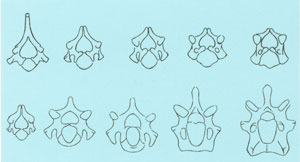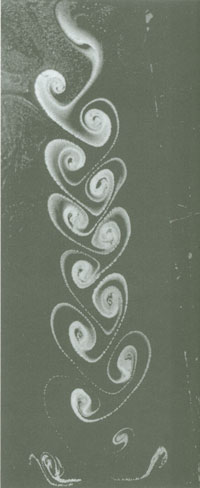|
Flowforms,
A book review by Maggie Lee

The theme of a past issue of Resurgence magazine was a “Time to Heal,” the title of an article by Prince Ch a rles (1). In it he asks, “The industrialization of Life will be a global obsession…and will there be enough local insurrections to slow its progress?” On this question hinges our sapient survival….i.e., applying the discerning wisdom nature has invested in us to sanely invent and design our niche in the environing world. 
John Wilkes relates in the introduction of Flowforms, the Rhythmic Power of Water, “This book is directed to those people with an open mind, who are interested in our environment and are willing to admit that it is in need of our active support and participation and this, in its own terms…the more subtle aspects which nature is trying to show us, if only we are willing to see.” Our earth is a conscious living intelligence with which we have a reciprocal connection; we are the consciousness of this earth. If we can trust this intelligence, it will teach us what we need to know. This is memoria naturae, nature remembering itself. [Right: Meander channel caused by flowing stream found below a glacier.] We can express through metaphor, our world’s industrialization as “self-regarding ego, intellectual precocity, trust in abstraction and our collapsing pretenses.” (2) An alternative choice is “value rich resonance of participation.” (3) 
With extraordinary depth of vision, John Wilkes in his new book, shares over 30 years' accumulation of ideas, experiments, experiences and creative, innovative designs with water. This he learned from trusting nature. Flowforms is beautifully illustrated with eloquent drawings and diagrams, often startling, vivid and memorable photographs of natural phenomenon and experiments, plus applications of Flowforms internationally. Further from the introduction, Wilkes reveals, “water is the element of movement, functioning in nature as universal mediator. Everything living is inevitably dependent upon water…the physical carrier of rhythm. Rhythm is a gateway.” [Left: Competition winning installation for the Deakin University in Melbourne, Australia.] In Sensitive Chaos, Theodor Schwenk advises “Water is an element that brings a state of balance everywhere. Rhythm is its life element and the more it can be active rhythmically, the more it remains alive in its innermost nature.” 
Wilkes continues, “Moving water is inseparable from surface. It either influences surfaces over which it flows or is influenced by them…and creates surfaces within its own volume.” [Right: Biological sewage plant for a small community on the west coast of Norway at Hogganvik.] Wilkes inquired “…could rhythm in conjunction with specific surfaces, have influence upon nature in a potentizing sense, supportive in a healing and harmonizing process?” 
He discovered in the Flowform, “a vessel, by virtue of its proportions, capable of inducing rhythms in water streaming through it.” This vessel, generally ovoid in shape, has a narrow entrance and exit, which creates a resistance, inducing an oscillating figure of eight (lemniscate) movement. Flowing into alternate sides, whorls or vortices form, folding the water upon itself, oxygenating, enlivening the inner mobility of its many surfaces, the basis of its vitality, its freshness. Wilkes describes properties demonstrated within the fluidic process. All are well illustrated with examples. [Above: Malmö Flowform, at Sundet, Mösvatn, Norway.] “Water is an element that sacrifices itself entirely to its surrounding. It comes under the influence of gravity and levity and due to these polar opposite agencies, it moves. Life moves within it and it moves within living creatures and those movements are always rhythmical. Rhythm is a gateway; a medium by means of which life can flourish. It becomes manifest physically as the phenomenon of metamorphosis.” 
Wilkes devotes an entire section in the appendix to metamorphosis. He includes a fascinating drawing of cow bones (at right) comparing the difference between growth and metamorphic processes. The other two sections of the appendix relate the design range of Flowforms and their varied applications and finally the scientific and technical parameters. 
“The path of vortices generated by a straight line movement through still water, demonstrates water’s potential for order and metamorphosis. It is this phenomenon that inspired the idea of building an ‘organ’ of metamorphosis for water, which in turn, led to the Flowform itself.” Special restorative value derives from water features designed in water's own terms…shaped surfaces caressed intimately by flowing, pulsing water. Certainly, this work can sensitize our awareness, while amplifying our experience of water and movement….a mutually beneficial influence. [Left: A path of vortices.] 
May we look into water metaphorically as a reflection of Nature beholding itself, while teaching us also, of the relationship between our thinking and inner flexibility. As earth is our witness. [Right: A very narrow object pulled through water, creates a train of parallel vortices.]
Footnotes:
All photos are from
Flowforms.
[Left: An original plaster prototype of a flowform
designed in conjunction with Hansjörg Palm and in the final stages
with Nick Weidmann.]
|

To install this Web App in your iPhone/iPad press ![]() and then Add to Home Screen.
and then Add to Home Screen.

